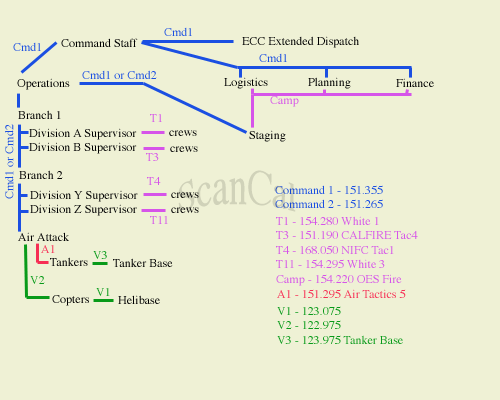Back to Incident Command System

|
|
What exactly do you want to listen to at a large incident?
Some scanner listeners don't want to hear every portion of the incident. The way ICS organizes communication, you can almost bet on certain aspects of the incident being on seperate radio channels. In that case, you pick what you want to listen to, and you don't have to hear anything else.
On the other hand, some like to hear everything they possibly can. In this case, the ICS will organize what you are listening to, and make the scanning job easier.
|
Command traffic takes place over the Command Net. All administrative functions of the fire is on Command Net, as well as the link between the Incident and dispatch. This seperates the actual firefighting from the decision-makers. Listen to the Command Net to obtain the overall health of the incident and anything happening behind the scenes. On very large complex fires, Operations might switch to a second Command Net, putting Operational traffic between Div Sups, Branches, Operations and IC on one Command Net, and Logistical and other administrative traffic on a second Command Net.
Tactical traffic is for localized units who need to coordinate how they are doing things. Therefore, separate Groups, Divisions etc. in the Operations Section usually get their own frequencies. Each Supervisor can monitor their local tactical traffic, as well as the command traffic to their Section Chief. This way firefighters only pay attention to their immediate supervisor, most likely the strike team leader or Div Sup.
Air Attack will monitor Command Net to get operational instructions, an Air Tactical Net to control the tankers, and possibly Copters on a third Victor frequency. They can also switch to an Air-Ground frequency and talk to any Div Sup, or even a single resource on a tactical frequency if needed for safety purposes on a particular drop.
Tankers when returning to base to reload will communicate with the base on the Natl Tanker Base freq of 123.975. When returning, they will check in with Air Attack typically 10 or 15 miles out on Air Tactics. When things get real busy with Rotary (helicopters), a Helicopter Coordinator (HelCo) will be assigned, and will be acting Air Attack for the copter operations. This will all take place on a Victor freq away from Air Tactics. Copters going to their temporary base (no need for an airport for copters) will contact Helibase on yet another frequency, usually called "Deck." This could be another Victor, or an FM freq such as the common 163.100 on federal fires.
Fire Camp will quickly become a small city during a large incident. Camp will typically have its own frequency for getting a hold of people around camp. On state fires, this has recently been OES Fire 1 or 2, although any available freq can be used. On a federal fire, usually a UHF Logistics frequency will be used.
